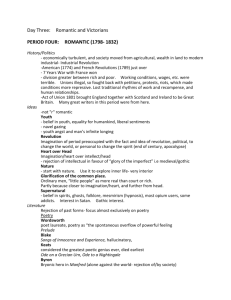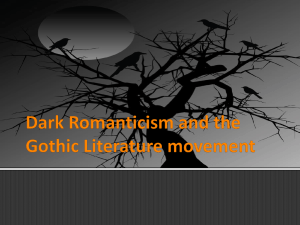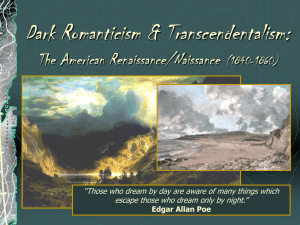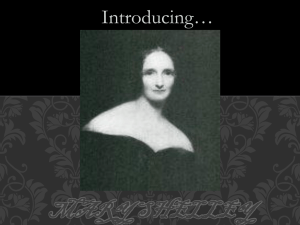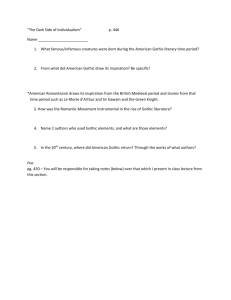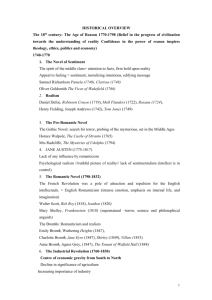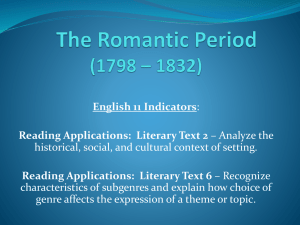File
advertisement
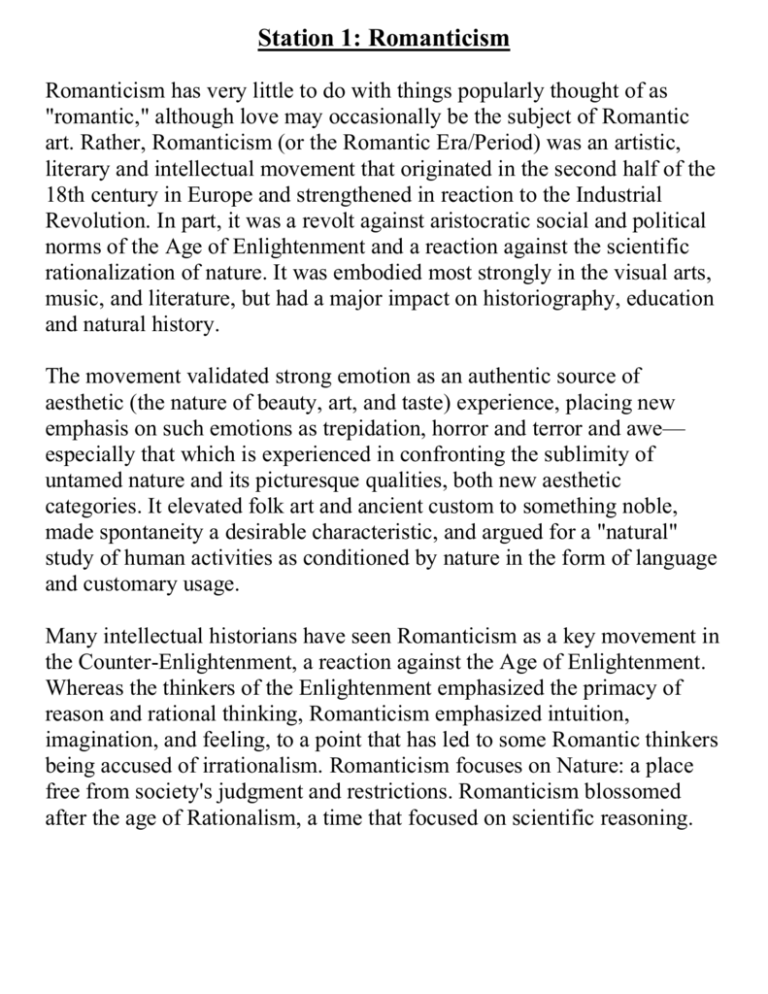
Station 1: Romanticism Romanticism has very little to do with things popularly thought of as "romantic," although love may occasionally be the subject of Romantic art. Rather, Romanticism (or the Romantic Era/Period) was an artistic, literary and intellectual movement that originated in the second half of the 18th century in Europe and strengthened in reaction to the Industrial Revolution. In part, it was a revolt against aristocratic social and political norms of the Age of Enlightenment and a reaction against the scientific rationalization of nature. It was embodied most strongly in the visual arts, music, and literature, but had a major impact on historiography, education and natural history. The movement validated strong emotion as an authentic source of aesthetic (the nature of beauty, art, and taste) experience, placing new emphasis on such emotions as trepidation, horror and terror and awe— especially that which is experienced in confronting the sublimity of untamed nature and its picturesque qualities, both new aesthetic categories. It elevated folk art and ancient custom to something noble, made spontaneity a desirable characteristic, and argued for a "natural" study of human activities as conditioned by nature in the form of language and customary usage. Many intellectual historians have seen Romanticism as a key movement in the Counter-Enlightenment, a reaction against the Age of Enlightenment. Whereas the thinkers of the Enlightenment emphasized the primacy of reason and rational thinking, Romanticism emphasized intuition, imagination, and feeling, to a point that has led to some Romantic thinkers being accused of irrationalism. Romanticism focuses on Nature: a place free from society's judgment and restrictions. Romanticism blossomed after the age of Rationalism, a time that focused on scientific reasoning. Station 2: Enlightenment VS Romanticism ENLIGHTENMENT ROMANTICISM People lack self-control Anti-social behavior is because people have not been taught right/wrong Leave people to themselves; their hearts are pure Anti-social behavior is because of societal pressures (schools, parents, etc.) Change Artificial change Take out old, put in new Organic Continual change and growth Education Education is important Teach each other Education should lay out choices Let the child choose Freedom should be limited Freedom should not be limited Republican government Representatives No representatives, only unanimous votes because group would function as whole unit Organic and changing Social contract — single ruler represents a group — bring person who is different around to what is “best” Anti-social behavior Freedom Government History is a movement to the better Looks down on the past History Morals Amoral (without morals) Not innate knowledge Virtuous Instincts Rule by an educated elite Rule by the masses because they know themselves All men are born alike or “created equal” Nurture not nature All men are unique or different Nature not nurture Voters should read and become informed before they vote Vote what is best for themselves Voters should follow their instincts and vote quickly Vote will be the best for all If you ask one person, you’ll know what everyone would want Rulers State of Nature Voting The importance of history is the search for an identity Ethnic groups claim land where they were at their greatest Ethnic groups carry culture through language Station 3: Industrial Revolution The Industrial Revolution was a period from the 18th to the 19th century where major changes in agriculture, manufacturing, mining, transportation, and technology had a profound effect on the social, economic and cultural conditions of the times. It began in the United Kingdom, and then subsequently spread throughout Western Europe, North America, Japan, and eventually the world. The Industrial Revolution marks a major turning point in history; almost every aspect of daily life was influenced in some way. Most notably, average income and population began to exhibit unprecedented sustained growth. In the two centuries following 1800, the world's average per capita income increased over tenfold, while the world's population increased six times over. Starting in the later part of the 18th century, there began a transition in parts of Great Britain's previously manual labor and animal–based economy towards machine-based manufacturing. It started with the mechanization of the textile industries, the development of iron-making techniques and the increased use of refined coal. Trade expansion was enabled by the introduction of canals, improved roads, and railways. With the transition away from an agricultural-based economy and towards machine-based manufacturing came a great influx of population from the countryside and into the towns and cities, which swelled in population. The introduction of steam power fuelled primarily by coal, wider utilization of water wheels and powered machinery (mainly in textile manufacturing) underpinned the dramatic increases in production capacity. The development of allmetal machine tools in the first two decades of the 19th century facilitated the manufacture of more production machines for manufacturing in other industries. The effects spread throughout Western Europe and North America during the 19th century, eventually affecting most of the world, a process that continues as industrialization. The impact of this change on society was enormous. The Second Industrial Revolution began around 1850, when technological and economic progress gained momentum with the development of steam-powered ships, railways, and later in the 19th century with the internal combustion engine and electrical power generation. Station 4: Viva la Révolutions American Revolutionary War (1775–83): the political upheaval during the last half of the 18th century in which thirteen colonies in North America joined together to break free from the British Empire, combining to become the United States of America. The French Revolution (1789–99): a period of radical social and political upheaval in France that had a major impact on France and indeed all of Europe. The absolute monarchy that had ruled France for centuries collapsed in three years. French society underwent an epic transformation as feudal, aristocratic and religious privileges evaporated under a sustained assault from radical left-wing political groups, masses on the streets, and peasants in the countryside. These wars, along with the political and social turmoil that went along with them, served as the background for Romanticism. The strong feelings that wartime produces served as a catalyst for an outpouring of art and literature, the likes of which had never been seen before. The works of the Romantic Era are a vast and unique collection of literary works. However, they can all be said to have at least these characteristics: A love of nature, a sense of nationalism, and a sense of exoticism/the supernatural. These simple characteristics can be linked back to the fact that these works were being written in time of political turmoil. For example, the nationalism seen in Romantic works may be attributed to the fact that the authors of the time took pride in their country, their people, and their “cause”. It was the writers’ way of contributing to the fight. The works of the Romantic Era also differed from preceding works in that they spoke to the “common” people. Romantics strove towards literature and arts that were for everyone, not just wealthy aristocracy. Much of the writing predating the Romantic Era was written for, and in the style of, only the wealthy upper classes. Romantics had a hand in changing this around—and it may have been because they were trying to connect with the commoners. In a time of war and political uneasiness, the writers were reaching out for a connection with their equals, not to those above them, the ones fueling the wars. During the Romantic period there was an increase in female authors as well. This can be attributed to the fact that this period was submerged in wartime. The women were at home, without a way to express their feelings, fight for the cause, or even connect to those around them. Station 5: Romantic/Gothic Literature The novel of manners: a literary genre that deals with aspects of behavior, language, customs and values characteristic of a particular class of people in a specific historical context. The genre emerged during the final decades of the 18th century. The novel of manners often shows a conflict between individual aspirations or desires and the accepted social codes of behavior. There is a vital relationship between manners, social behavior and character. Physical appearances are overall less emphasized while manners and social behavior remain the particular interests in the novel. The idea of manners assumes not only a social significance, as it is applied today, but a moral one as well, which preceded the social context in which it was used. What connects the two is the idea of "pleasing". Characters in the novels are not always morally and socially obliging to each other, however, but there is differentiation between the upstanding hero or heroine and the socially less acceptable characters. The different degrees of how the characters uphold the standard level of social etiquette is what usually dominates the plot of the novel. Another theory for the emergence and growth of the novel of manners is that the changes taking place in English society were eroding the class boundaries. Changes in the social hierarchy were taking place due to leaps in technology and the novel of manners was a way to reestablish this class order. The different classes represented in the novels served to represent how the different classes in society were supposed to behave in different settings. This includes public versus private, rural versus urban, and settings where there were men versus women. This contrast between the genders highlights the fact that there were many more women that were authors of novels of manners than there were men. This brought the focus of many of these novels to the social issues and conventions that plagued women of the time. Gothic fiction: sometimes referred to as Gothic horror, this is a literary genre that combines elements of both horror and romance. Gothicism's origin is attributed to English author Horace Walpole, with his 1764 novel The Castle of Otranto, subtitled "A Gothic Story". The effect of Gothic fiction feeds on a pleasing (cathartic) sort of terror, an extension of Romantic literary pleasures that were relatively new at the time of Walpole's novel. Prominent features of Gothic fiction include terror (both psychological and physical), mystery, the supernatural, ghosts, haunted houses and Gothic architecture, castles, darkness, death, decay, doubles, madness, secrets and hereditary curses. This near-simultaneous emergence of the novel of manners and the Gothic novel led to a crossover of characteristics between the genres. The main link between the novel of manners and the Gothic novel is the language of manners. In both cases, social and moral manners are dominating factors in the structure of the novel. In the Gothic novel, the starkest difference is the supernatural or the indication of supernatural events. However, many of the characters are often so far below the accepted level of social behavior that it is considered horrific. Another feature that differs from the novel of manners is the outcome of the novel. In Gothic fiction, the outcome is not always the positive reinforcement of morals that the novel of manners offers. Station 6: Mary Shelley Mary Wollstonecraft Godwin was born on August 30, 1797 in London, England, the second daughter of Mary Wollstonecraft and William Godwin. Mary’s mother died soon after her birth and she and her half sister Fanny gained a stepsister, Claire, when her father remarried. Claire and Mary would remain very close for the rest of their lives. There were bitter times for Mary growing up with a cruel step mother and emotionally distant father; she consoled herself at her mother’s graveside and spent periods of time in Scotland with friends of the family. She was educated at home by tutors where she studied her parent’s writings and literature and poetry, as well as learning Latin, French, and Italian. She also read the works of the Enlightenment literary figures her unorthodox parents associated with, including the poets William Blake, Samuel Taylor Coleridge, and Charles Lamb. Mary met her future husband Percy Bysshe Shelley around the age of sixteen when he became acquainted with her atheist father and his philosophy, which he soon adopted. He spent much time at the Godwin’s household discussing politics and events of the day. Percy was unhappily married to Harriet Westbrook at the time, and despite Mary’s father forbidding her to see him anymore, he and Mary eloped to France in 1814 with Claire in tow for a six week tour of Europe. Mary’s father’s free love philosophy did not extend to her, and they were estranged until she married. Living in London with Claire and Percy, Mary and Percy’s daughter Clara was born in February of 1815 though she died a few weeks later. Soon after, William was born (1816-1819) and the trio set out again, traveling through France, Germany, and Switzerland. Advocates of vegetarianism and issues of social reform, the Shelley’s were matched on many levels intellectually though Mary did not embrace the idea of an open marriage or ‘true love’ ideals Percy longed for and expressed in so many of his poems. While at Lake Geneva in Switzerland with Lord George Gordon Byron, she had started writing Frankenstein in 1816, inspired by their many sailing trips on the lake and nights telling each other ghost stories. A second daughter named Clara was born in 1817 but she died a year later. Now that they were married and Mary was on speaking terms with her father, she and Percy moved back to Italy, staying for a time in various cities including Milan, Pisa, and Venice. While living in Florence, Percy Florence was born in 1819, the same year William died. In 1822, Shelley suffered a miscarriage which almost took her life. The same year, as was one of his favorite past times, Percy was sailing on his schooner ‘Don Juan’ with friend Edward Williams when a sudden storm blew up and it sank. Percy’s body washed ashore, and as were his wishes, he was cremated on the beach near Viareggio. Devastated by her loss, in 1823 Mary returned to England with her son Percy. She died at home in London at the age of 54 on February 1, 1851, and she lies buried in St. Peter’s churchyard in Bournemouth, Dorset, England. Station 7: Cautionary Tales A cautionary tale is a tale told in folklore, to warn its hearer of a danger. There are three essential parts to a cautionary tale (though they can be introduced in a large variety of ways): First, a taboo or prohibition is stated: some act, location, or thing is said to be dangerous. Then, the narrative itself is told: someone disregarded the warning and performed the forbidden act. Finally, the violator comes to an unpleasant fate, which is frequently related in expansive and grisly detail. Cautionary tales are ever-present in popular culture; many urban legends are framed as cautionary tales: from the lover's lane haunted by a hook-handed murderer to the tale of a man who shot a cactus for fun only to die when the plant toppled onto him. Like horror fiction, generally the cautionary tale exhibits an ambivalent attitude towards social taboos. The narrator of a cautionary tale is momentarily excused from the ordinary demands of etiquette that discourages the use of gruesome or disgusting imagery because the tale serves to reinforce some other social taboo. On the other hand, in the adolescent culture of the United States, for more than a hundred years the traditional cautionary tale gave rise to the phenomenon of legend tripping, in which a cautionary tale is turned into the basis of a dare that invites the hearer to test the taboo by breaking it. Station 8: Prometheus (Greek Myth) In Greek mythology, the Titan named Prometheus was the creator of mankind. The goddess Athene taught him architecture, astronomy, mathematics, navigation, medicine, and metallurgy, and he in turn taught them to humans. Zeus, the chief of the Greek gods, became angry at Prometheus for making people powerful by teaching them all these useful skills. When the gods chose Prometheus as arbiter in a dispute, he fooled the gullible Zeus into picking the worst parts of the sacrificial bull by hiding them under a rich layer of fat. To punish Prometheus, Zeus withheld fire from men. "Let them eat their flesh raw," he declared. In response, Prometheus, snuck up to Mount Olympus, lit a torch from the sun, and hid a burning piece of charcoal in a hollow stalk. He slipped away with it and thus delivered fire to mankind. Zeus, as revenge, tried unsuccessfully to trick Prometheus' brother, Epimetheus, into accepting the beautiful but mischievous Pandora as a gift. Epimetheus, mindful of earlier advice from his brother, refused. Even madder now that his trick had failed, Zeus had Prometheus chained naked to a pillar in the Caucasian mountains. A griffon-vulture ate at Prometheus' liver all day long. During the bitter cold of the mountain night, the liver became whole again. So it went day after day, year after year. Epimetheus married Pandora in an effort to free his brother. Pandora -- as devilish as she was beautiful -opened the famous box in which Prometheus had shut up all the evils that might plague mankind: Old Age, Labor, Sickness, Insanity, Vice and Passion. Only years later, at the behest of Heracles (Hercules), did Zeus free Prometheus. Station 9: Catharsis Catharsis is a term in dramatic art that describes the "emotional cleansing" sometimes depicted in a play as occurring for one or more of its characters, as well as the same phenomenon as (an intended) part of the audience’s experience. It describes an extreme change in emotion, occurring as the result of experiencing strong feelings (such as sorrow, fear, pity, or even laughter). It has been described as a "purification" or a "purging" of such emotions. The Greek philosopher Aristotle was the first to use the term catharsis with reference to the emotions – in his work Poetics. In that context, it refers to a sensation or literary effect that, ideally, would either be experienced by the characters in a play, or be wrought upon the audience at the conclusion of a tragedy; namely, the release of pent-up emotion or energy. In psychology, the term was first employed by Sigmund Freud's colleague Josef Breuer (1842-1925), who developed a "cathartic" treatment for persons suffering from hysterical symptoms through the use of hypnosis. While under hypnosis, Breuer's patients were able to recall traumatic experiences, and through the process of expressing the original emotions that had been repressed and forgotten, they were relieved of their symptoms.
